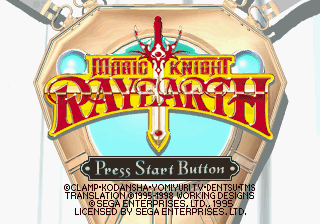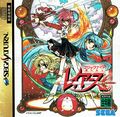Difference between revisions of "Magic Knight Rayearth (Saturn)"
From Sega Retro
m |
Scarred Sun (talk | contribs) |
||
| Line 53: | Line 53: | ||
| 1 | | 1 | ||
|} | |} | ||
| + | |||
| + | ==Physical Scans== | ||
| + | <gallery> | ||
| + | File:Mkr sat jp frontcover.jpg|JP cover (front) | ||
| + | File:Mkr sat jp backcover.jpg|JP cover (back) | ||
| + | </gallery> | ||
[[Category:Saturn Games]] | [[Category:Saturn Games]] | ||
Revision as of 14:01, 30 March 2010
| Magic Knight Rayearth (Saturn) |
|---|
| System(s): Sega Saturn |
| Publisher: Sega, Working Designs |
| Developer: Sega |
| Genre: Action, RPG |
Magic Knight Rayearth is a Sega Saturn video game based upon the CLAMP anime series of the same name. It was developed by Sega, and was later brought to the US by Working Designs. It's infamous for being the last Sega Saturn game released in America and was never released in Europe.
Working Designs Translation Notes
Taken from the US manual.
Magic Knight Rayearth is based on a Japanese anime series that was enormously popular. When we first heard about the game WAY back in 1995, we were seriously interested in doing the US version. Once we SAW the game, that was it, we had to do it. We were warned that a hard disk crash had wiped out some data after the Japanese version was finished, but we were confident the data could be rebuilt.
Fast forward almost 30 months. It took us the bulk of this time to overcome problems with approval for the English version's names (Which are very close to the tralsliterated Japanese names in most cases), data that was missing from the hard disk crash, and various programming and version problems that became apparent in the course of conversion. For these and other reasons, this has been, without a doubt or question, the most grueling conversion we have ever attempted. But, it's done, and your extreme patience as a Saturn owner has been rewarded now that you have it in your possession. So then, let's talk about what was done for the US version.
One of the first areas that we targeted to fix was the save system. The original Japanese version only allowed three saves. Because the game is stuffed with tons of awesome animation, we thought it would be cool to allow a lot of saves so a player could save near favorite events and access them quickly. Therefore, the US version will allow saves up to the capacity of the built-in RAM or the External RAM cartridge, whichever the player chooses. Another important change we made was in the area of slowdown. Polizu initially had a large degree of slowdown due to the large number of sprites being used and animated. By doing a sprite consolidation and reduction, we were able to improve this area and a number of others so that the slowdown is much less noticeable, if at all, with no perceptible change to the look and feel of the town. One area we weren't able to fix was in Rosen. Due to the multilevel structure of the town, we were unable to achieve much of an improvement under the current system. Forgive us, we tried.
When testing the game initially, we found that a large number of players found it very annoying that many, many people in towns talked to you. It slowed down the flow of the game. So, we just kept the Prologue audio up to Precia's mansion, then left in only in-game speech during key events. We used the CD space reclaimed to add a "audible diary" feature where each diary entry can be read out loud by the person who wrote it at the press of a button. This was much cooler because it became an optional feature that extended the game, instead of a mandatory one that slowed it down. The diary entries are also penned in the girl's own handwriting, instead of a standard font.
The Japanese game also featured a quest for Rainbow amulets. If the player got them all, they unlocked a music test called "Mokona's home." In the US version, we added our traditional outtakes mode as another option that opens once all the amulets are retrieved. This is the first time we've given players absolute control over the outtakes play order, since ANY character's outtake file can be played on demand. Outtakes are one of our most popular "extras." We hope you like the special way we've implemented it in this game.
Finally, the original Japanese logo had three gems morphing into the red lettering of the Japanese logo. Initially, we made a logo that allowed us to copy the look and feel of the Japanese logo sequence of the opening animation. However, we were made aware of a logo created for the English Rayearth, so the opening animation was changed again to allow for the new logo's use. Unfortunately, due to the design of the logo, we couldn't incorporate the morph like the original Japanese opening. We were also not able to obtain the rights to the original opening song, so we made one that retained the "feel" of the original, but was completely new.
Chances are, this is the last SEGA Saturn game to be released in the US. We'd like to take this opportunity to thank you for your long and continued support. We'll keep doing great RPG's as long as you keep buying them. Remember, we're nothing without you.
Saving Data
Magic Knight Rayearth makes use of the Saturn's internal battery back-up as well as the Sega Saturn Back-Up Ram Cart to save progress. In the Japanese version, you can save up to three slots on either internal memory. In the US version, Working Designs added three more save slots and the ability to save with the Back-Up Ram Cart. In addition, the US version creates one more save fine if the game is completed to allow players to listen to audio outtakes.
| Name | Comment | File Size |
|---|---|---|
| RAYEARTH_## | ####XMM/DD | 68 |
| RAYEARTH_ST | SND_TEST | 1 |
| RAYEARTH_EX | COMPLETE | 1 |


